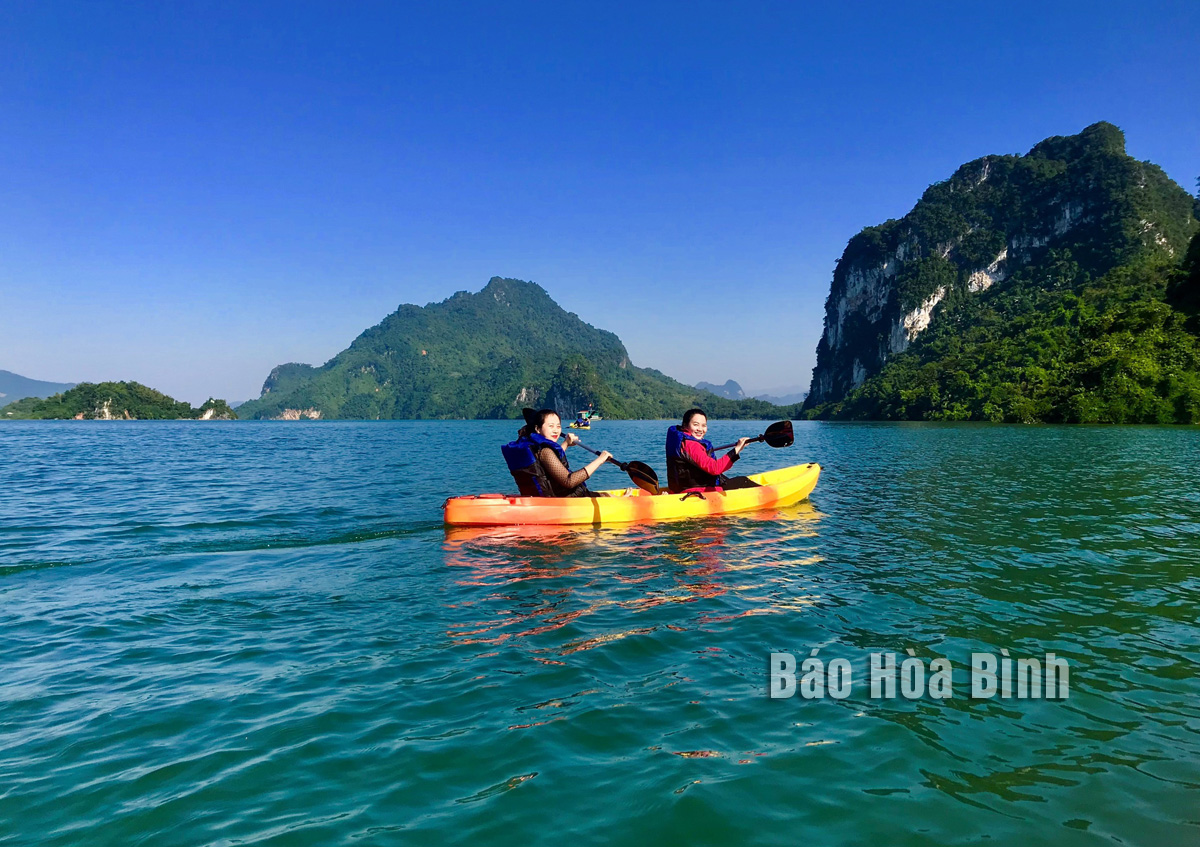
Together with community-based tourism, Mai Chau district is focusing on developing eco-resort tourism around Hoa Binh lake in Son Thuy commune.
Tourists enjoy kayaking on Hoa Binh lake.
Son Thuy commune - home to Muong and Thai ethnic groups - still retains untouched nature with rolling mountains and peaceful villages along Hoa Binh lake, thus attracting tourists, especially young backpackers. In the winter, the area is often blanketed with thick fog, reminding many people of the famous resort town of Sa Pa in the northern province of Lao Cai.
Rich natural resources and unique cultural identity are advantages for the commune to develop tourism. Initially, some backpackers discovered the area and came to explore the area. Later, some businesses surveyed and invested in building hotels and resorts to meet the high-end tourist market segment.
Notably, Mai Chau Hideaway resort and Ba Khan Village in Son Thuy commune affirmed their positions in attracting visitors to the Hoa Binh lake tourist area in particular and Hoa Binh tourism in general.
Ha Thi Lieu, deputy head of the Culture and Information Department of Mai Chau district, said that the formation of high-end ecological resort destinations helps increase the attractiveness of the Hoa Binh lake tourist site, promoting local tourism. Some households in the area have provided homestay services for tourists, offering more choices to experience local culture. Local eco-resorts have recovered strongly after the COVID-19 pandemic, inspiring investors to continue to seek investment opportunities.
Resorts and hotels in the tourist area attract tourists all year round, the room occupancy rate ranges from 50 - 70% on working days, and 90 - 100% on weekends. In particular, Mai Chau Hideaway is preferred by international visitors with about 70% of its guests coming from European and American countries.
A diverse chain of eco-tourism and resort destinations concentrated in Hoa Binh city and the districts of Tan Lac, Da Bac, and Luong Son… Along with the launch of several key high-quality resort tourism projects, these developments have reshaped the landscape and enhanced the appeal of Hoa Binh as a travel destination.
Boasting diverse terrain, a mild climate, and rich natural resources, Cao Phong district is increasingly asserting its place on Vietnam’s tourism map, attracting both domestic and foreign visitors. The district is renowned for its stunning landscapes, majestic mountains, a crystal-clear hydropower lake, and the unique cultural identity of local ethnic groups.
With its pristine landscapes, unique cultural heritage of Muong ethnic minority, and an expanding range of visitor experiences, Tan Lac district of Hoa Binh has fast become a captivating destination for both domestic and international tourists.
Until now, Sung village in Cao Son commune, Da Bac district remains the only Dao ethnic community in Hoa Binh province to develop a community-based tourism model. Beyond its untouched natural landscapes, cultural identity serves as the cornerstone attraction for visitors.
Alongside the diverse cultural identities of the Kinh, Muong, Tay, Thai, Dao, and Mong ethnic people, Hoa Binh province is also renowned as the "capital" of the northwestern Vietnamese cuisine, offering unique and distinctive dishes. At festivals, during Lunar New Year (Tet), or on significant family or community occasions, special dishes are prepared, leaving a lasting impression on visitors.
A Phong Linh (Yellow Tabebuia) flower garden in Thang village, Thach Yen commune, Cao Phong district is currently in full bloom, drawing a large number of visitors.



